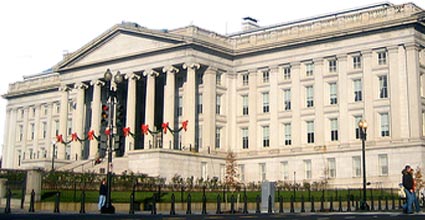
White House photo.
“We’re the United States of America; we are not Sweden.” That’s how Treasury Secretary Timothy Geithner defended what his department calls the “Public-Private Investment Program for Legacy Assets,” which could also be dubbed the “buying up Wall Street’s crap program.” During a press briefing with reporters on Monday morning in a second-floor Treasury Department conference room—no TV cameras allowed!—Geithner laid out the basics of the toxic assets program the White House would be unveiling an hour or so later. Regarding Sweden, his point was that the Obama administration had concocted a blended approach to cleaning up Wall Street’s mess. Not too much government involvement (and risk) and not too much private sector participation, but a mix that is just right.
The program has two parts: buying up bad loans and buying up bad securities. A Treasury Department fact sheet contained a simple explanation. Say a bank has a pool of residential mortgages with $100 face value that it wants to dump. The bank would approach the FDIC, which would then determine how much it was willing to leverage for this batch of mortgages. In this example, the FDIC determines it’s willing to go with a 6-to-1 debt-to-equity ratio. Then the FDIC auctions the pool to private sector bidders. Assume the winning bid is $84. Next, the successful bidder puts together a “public-private investment fund.” The FDIC provides guarantees for $72 of the financing. The Treasury kicks in $6, and the private bidder puts in six dollars and goes on to manage the assets and their ultimate disposition—using FDIC-approved asset managers.
Bottom line: Private firms can buy loans with a face value of $100 by putting only $6 of skin into the game. Too good a deal? Of course, that depends on what this stuff ends up being worth. But if I read this right, the taxpayers are on the hook for the $72 in guarantees and the $6 in matching equity. So the feds are shouldering much more of the risk burden than the private firms. Yet the feds would not get any greater split of the profits—if they ever materialize.
I asked Geithner if such a setup might come across to folks outside the Beltway as a cushy deal for private firms. He first quipped that he was confident that the reporters in the room would do a good job in presenting the details of the program to the public. He then said that the key point is evaluating this arrangement against other alternatives. And he only mentioned two other possibilities: having the government buy all this junk on its own, or doing nothing and letting the process of “de-leveraging” within the financial system—that is, the collapse of credit—continue.
That was the mantra of the day: This may not be the best deal, but it’s the best deal we’ve got. Treasury’s fact sheet noted, “This approach is superior to the alternative of either hoping for banks to gradually work these assets off their books or of the government purchasing the assets directly.” But is there nothing else?
The Obama administration’s strategy is to make it seem that there’s really no choice here and that the country just has to suck it up. Geithner presented the plan with confidence. He acknowledged the “deep skepticism” and “deep anger” of the American public. He talked about the need to get credit flowing. He explained that the financial system’s main problem has gone from excessive risk taking (which led to economic calamity) to insufficient risk taking (which has caused a credit freeze that threatens to strangle the economy further). Asked how the success (or lack thereof) of this plan could be measured, he calmly noted that the level of participation in the fire sale of toxic assets will not in itself signal success or failure. The plan, he said, should be judged on what happens to the overall movement of credit. If credit starts flowing, voila! He compared the program to a backstop at a baseball field. The backstop works if it changes behavior (prevents people from throwing a ball wildly), not only if it prevents a ball from flying into the stands.
Geithner was a strong advocate of what could well be a flawed plan. In Washington, presentation can be as important as policy. (Just ask those skittish “markets.”) But in the long run, it’s policy that counts. This plan seems like a pretty good arrangement for freewheeling banks and private firms eager for vulture-like deal making. Geithner’s confidence-building skills may not yet be up to the task of persuading angry Americans that this is also in their best interests.















